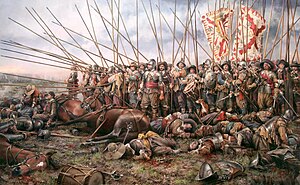Ten Years' War
This article is incomplete because it is pending further input from participants, or it is a work-in-progress by one author. Please comment on this article's talk page to share your input, comments and questions. Note: To contribute to this article, you may need to seek help from the author(s) of this page. |
| Ten Years' War | |||||||
|---|---|---|---|---|---|---|---|
 A Soravian army overlooking the battlefield after the Battle of Brambauer, 1712 | |||||||
| |||||||
| Belligerents | |||||||
|
| ||||||
| Commanders and leaders | |||||||
| |||||||
| Strength | |||||||
|
Scovern: 83,000 Soravia: 116,000 |
Rudolphine Confederation: 60,000 Vespasian League: 267,000 | ||||||
The Ten Years' War (Gaullican: Guerre de dix ans) alternatively known as the War of the Ruttish Succession was a war fourght primarily in northern and central Euclea between 1711 and 1721 but also encompassing Asteria Superior and Inferior. Spanning a decade and involving most of Euclea's forefront military powers, it was one of the largest Euclean wars fought in history at the time. Belligerents included the Soravian Empire, Scovern, the Rudolphine Confederation, the Estmerish Empire, and later, the Gaullican Empire and Paretia. The war saw millions of troops mobilised by respective powers and widespread razing, destruction of infrastructure as well as scorched earth tactics. In eastern Euclea, the war brought great famine which killed thousands of civilians through poor harvests and destruction of markets.
In 1696, Soravia and Scovern entered a military and diplomatic alliance. Soravia's claims to the duchies of Kantemosha and Ambrazka were affirmed by Platavia (then ruled by the King of Scovern in personal union), while Soravia agreed not to intervene in any Platavian expansion east into the Rudolphine Confederation. The death of the Grand Duke of Ruttland led to a dispute between Scovern and Cislania who both claimed the Ruttish throne. Discontent between members of the Rudolphine Confederation, particularly the imperial house and more peripheral regions such as Azmara made Scovern, Platavia, Soravia and Azmara the initial belligerents in 1711 when all four declared war on Cislania (and by extension the confederation) and Kantemosha. A web of alliances eventually brought the Kingdom of Estmere and the Vespasian League into the conflict, opening a new frontier in the new world that included conflict in Vinalia, Aucuria and Gapolania, as well as naval engagements in the Vehemens, Arucian and Lumine.
Blockades in Werania by the Soravian and Scovernois navies contributed greatly to the stifling of trade. Their land forces also succeeded in Euclea, occupying Kantemosha fully by 1713, with Scovernois–Platavian forces also making significant inroads into Ruttland, laying siege to Šilokrautė in 1715, though the personal union between the two countries had ended with the abdication of Carl Frederick I in 1714. In the new world, Estmerish and Povelian navies held naval dominance over the Soravian navy, dealing decisive blows at Cubulco Gulf and the Strait of Secanton, disrupting colonial logistics and occupying the developed island of Kisharsk in the process.
In 1717, Soravian emperor Casimir III sent a small delegation led by Count Loskutoff-Savin, the chancellor of Soravia, to Gaullica and Paretia. Promised vast swathes of colonial land, Gaullica entered the war in 1717. This was followed by the entrance of Paretia, promised much of Ardesia. Gaullica led a large land offensive into Estmere the same year, forcing Estmerish forces in Werania to be re-routed to defend. Protected by the Transaventine mountains, it was able to focus most of its land forces north. Its navy was able to relieve Soravian ships by beating back a joint Estmero-Povelian naval force at the decisive Battle of the Arucian in 1719, liberating Kisharsk. As Rudolphine forces collapsed, Ruttland was occupied by Scovern. Many principalities surrendered separately to the invading Kirenian forces. Soravia attempted to launch an offensive into Ardesia but the heat and dense jungle caused it to be abandoned shortly after. The League's navy was beaten in Euclea by a joint Gallo-Soravian force at the Battle of the Solarian Sea in 1720. Marred by internal unrest and financial ruin, Scovern declared bankruptcy in 1720. The League surrendered in January 1721, followed by Estmere in March, ending the war.
In the ensuing Congress of Cislania, many land changes including the annexation of Kantemosha into the Soravian Empire, the annexation of Ruttland into Kirenia and small expansions to the Principality of Wittislich took place. In the new world, Povelia ceded Belmonte and Estmere ceded some of its colonies to Gaullica and Ruttland ceded Aucuria to the Rudolphine Emperor. Scovern made no gains in the conflict as a result of its bankruptcy. Outside of the congress, political outlook in Euclea changed massively as a direct result of the war. The Rudolphine Confederation undertook an agenda of centralisation while Soravia and Kirenia both emerged as great powers in Euclea. As well as this, the beginnings of liberalism and republicanism began to emerge in philosophical circles, as well as the gradual development of pan-Weranicism. The war remains one of the deadliest in Euclean history, with severe military and civilian casualties on top of mass economic decline and famine that occurred as a direct result of the conflict.